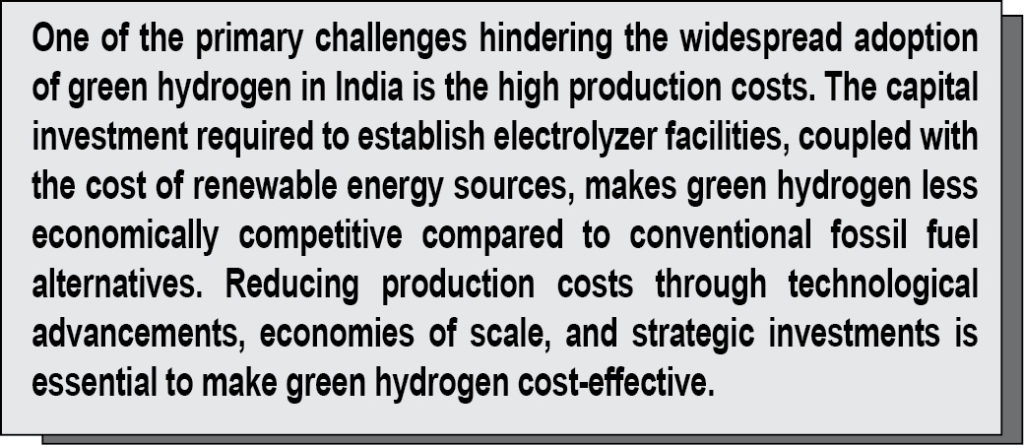Abstract
India’s ambitious goals to reduce carbon emissions and transition towards cleaner energy systems have sparked interest in green hydrogen as a viable solution. Green hydrogen, produced through the electrolysis of water using renewable energy sources such as solar and wind, has the potential to decarbonize various sectors, including transportation, industry, and power generation. This paper explores the challenges faced by green hydrogen in India and presents possible solutions to unlock its full potential for India’s clean energy future.
Introduction
India has set ambitious goals of achieving energy independence by 2047 and reaching net-zero emissions by 2070. To facilitate this transition, the country is focusing on increasing the use of renewable energy in all sectors. Green Hydrogen is seen as a promising solution to support this transition. It can be utilized for long-term storage of renewable energy, replacing fossil fuels in industries, enabling clean transportation, and potentially even decentralized power generation, aviation, and marine transport.
To drive the adoption of Green Hydrogen, the Indian government approved the National Green Hydrogen Mission on January 4, 2022. The objectives of this mission include making India a leading producer and supplier of Green Hydrogen globally, creating export opportunities for Green Hydrogen and its derivatives, reducing dependence on imported fossil fuels, developing indigenous manufacturing capabilities, attracting investments and business opportunities, creating employment opportunities and fostering economic development, as well as supporting research and development projects.
 By 2030, the mission aims to achieve several outcomes, including developing a green hydrogen production capacity of at least 5 million metric tonnes per annum, adding approximately 125 GW of renewable energy capacity, attracting over Rs. 8 lakh crore in total investments, creating over six lakh jobs, reducing cumulative fossil fuel imports by over Rs. 1 lakh crore, and abating nearly 50 million metric tonnes of greenhouse gas emissions annually.
By 2030, the mission aims to achieve several outcomes, including developing a green hydrogen production capacity of at least 5 million metric tonnes per annum, adding approximately 125 GW of renewable energy capacity, attracting over Rs. 8 lakh crore in total investments, creating over six lakh jobs, reducing cumulative fossil fuel imports by over Rs. 1 lakh crore, and abating nearly 50 million metric tonnes of greenhouse gas emissions annually.
Challenges Faced by Green Hydrogen in India
High Production Costs
One of the primary challenges hindering the widespread adoption of green hydrogen in India is the high production costs. The capital investment required to establish electrolyzer facilities, coupled with the cost of renewable energy sources, makes green hydrogen less economically competitive compared to conventional fossil fuel alternatives. Reducing production costs through technological advancements, economies of scale, and strategic investments is essential to make green hydrogen cost-effective.
Limited Renewable Energy Infrastructure
 India’s renewable energy infrastructure, while rapidly growing, still faces challenges in terms of availability, reliability, and transmission. A robust renewable energy infrastructure is vital for the large-scale production of green hydrogen. Expanding renewable power generation capacity, improving grid integration, and developing energy storage solutions are crucial to ensure a consistent and cost-effective supply of renewable energy for green hydrogen production.
India’s renewable energy infrastructure, while rapidly growing, still faces challenges in terms of availability, reliability, and transmission. A robust renewable energy infrastructure is vital for the large-scale production of green hydrogen. Expanding renewable power generation capacity, improving grid integration, and developing energy storage solutions are crucial to ensure a consistent and cost-effective supply of renewable energy for green hydrogen production.
Lack of Dedicated Infrastructure and Storage Facilities
The lack of a dedicated hydrogen infrastructure, including transportation, storage, and distribution facilities, poses a significant challenge for the adoption of green hydrogen in India. Establishing a comprehensive hydrogen infrastructure requires substantial investments and coordinated efforts. Building hydrogen refueling stations, storage facilities, and pipeline networks will be critical to facilitate the seamless integration and utilization of green hydrogen across various sectors.
Need for a Supportive Policy and Regulatory Framework
The absence of a clear policy and regulatory framework specifically tailored to green hydrogen is another major challenge. India needs comprehensive policies that provide financial incentives, subsidies, and long-term commitments to foster the growth of green hydrogen. Creating a supportive regulatory environment that addresses licensing, permitting, and standardization issues will provide certainty and encourage private sector investments in green hydrogen projects.
Solutions for India’s Clean Energy Future
Research and Development
Investing in research and development (R&D) is crucial to overcoming the challenges faced by green hydrogen in India. Collaboration between industry, academia, and research institutions can drive technological advancements in electrolyzer efficiency, durability, and cost-effectiveness. R&D efforts should focus on developing advanced materials, efficient catalysts, and innovative manufacturing processes to reduce production costs and improve overall system performance.
Financial Incentives and Support
To incentivize private sector participation in green hydrogen projects, the government should provide financial incentives and support mechanisms. These may include tax incentives, grants, subsidies, and concessional financing options. Establishing dedicated funds and financing mechanisms specific to green hydrogen projects will help overcome the initial investment barriers and promote the growth of green hydrogen in India.
International Collaborations
India can benefit from international collaborations and partnerships to access advanced technologies, expertise, and knowledge sharing. Collaborating with countries leading in green hydrogen production and infrastructure development can help expedite India’s transition to a hydrogen-based economy. International partnerships can facilitate technology transfer, joint research initiatives, and the establishment of global standards for green hydrogen production, storage, and utilization.
Public Awareness and Capacity Building
Creating awareness among the public, policymakers, and industries about the potential benefits of green hydrogen is essential. Conducting capacity-building programs, workshops, and knowledge-sharing initiatives can help disseminate information about green hydrogen technologies, applications, and economic advantages. Educating stakeholders about the environmental benefits and long-term sustainability of green hydrogen will foster a supportive ecosystem and encourage its adoption.
Conclusion
Unleashing the power of green hydrogen is vital for India’s clean energy future. Overcoming the challenges of high production costs, limited renewable energy infrastructure, lack of dedicated infrastructure and storage facilities, and the absence of a supportive policy and regulatory framework requires collaborative efforts from government, industry, academia, and international partners. By prioritizing research and development, providing financial incentives and support, fostering international collaborations, and raising public awareness, India can unlock the full potential of green hydrogen and pave the way towards a sustainable and carbon-neutral future. Embracing green hydrogen will not only help India achieve its climate goals but also create new opportunities for economic growth, energy security, and technological innovation.
The conclusions presented in this article are solely those of the authors and cannot be ascribed to Fluor Corporation and / or any of its subsidiaries.































